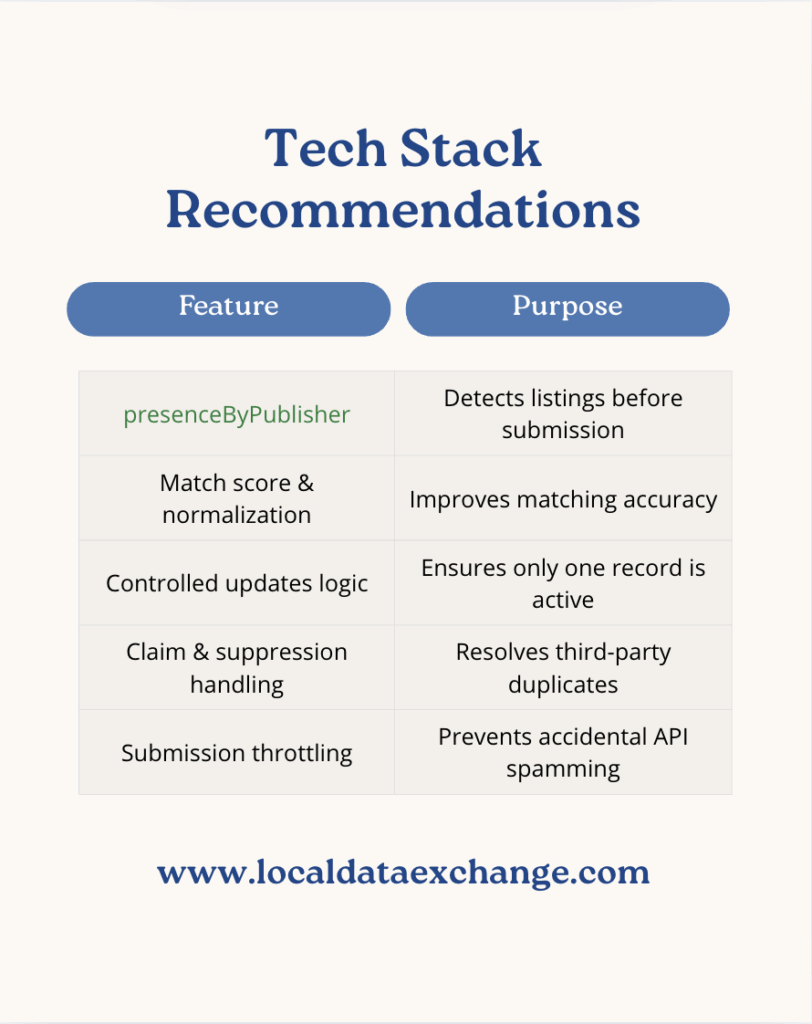For multi-location brands and SaaS platforms that manage online presence, the most frustrating part of business listings management isn’t just the submissions, it’s the duplicates. Duplicate listings confuse customers, split SEO signals, and increase the chance of outdated or incorrect information floating across the web.
At Local Data Exchange, we understand that data integrity is the foundation of strong local SEO. That’s why our Listings API was built with smart, scalable deduplication baked into the core, not as an afterthought or manual task.
In this post, we’ll walk through how our Listings API handles deduplication at scale, why it matters for SEO and brand trust, and how it works in real-time across publishers.
Why Deduplication Is Critical
Before we dive into the how, let’s clarify the why:
- SEO Impact: Multiple listings for the same business can dilute ranking power and confuse Google’s index.
- Customer Experience: Inconsistent hours or addresses across duplicates can lead to lost visits or negative reviews.
- Reputation Management: You can’t manage what you don’t see. Duplicate listings often fall outside your response workflow.
When you manage hundreds or thousands of locations across Google, Yelp, Apple Maps, Bing, and dozens of niche directories, manual deduplication is not an option. It has to be smart, fast, and automated.
The Local Data Exchange Approach to Deduplication
Our Listings API tackles deduplication through a multi-step process that checks for, flags, and resolves potential duplicates before and during submission.
1. Presence Detection Before Submission
Before any listing data is pushed to a publisher, you can use our presenceByPublisher endpoint to detect existing listings tied to your business profile. This prevents unnecessary resubmissions or the creation of redundant records.
How it works:
- You submit a location’s NAP (Name, Address, Phone) and optional identifiers.
- The API returns publisher-specific presence data, including:
- Whether the business is already listed
- A matched record or profile ID (if found)
- Current status of the listing (active, pending, duplicate, etc.)
- Whether we have control or access to update the record
- Whether the business is already listed
Reference: presenceByPublisher endpoint in our docs » https://api.ldex.co/listings-management/docs#tag/Presence
This allows your system to make decisions about which locations need updates, which are new, and which may need to go through a merge or claim process.
2. Matching and Normalization Rules
We use internal logic and match scoring based on:
- NAP similarity (with fuzzy matching)
- Website and domain references
- Geo-coordinates and zip code proximity
- Phone number format normalization
- Business category context
These rules are tuned per publisher since each platform uses different data structures and thresholds for merging or rejecting duplicates.
3. Preventing Duplicate Submissions via Publisher Control
Many platforms let agencies and third-party systems submit listings blindly, leading to unintentional duplication. We don’t. Our system checks whether:
- The business is already managed through our API and you can update it directly
- The listing is already claimed or verified
- Another submission would create a conflict
This ensures no double submissions, which can trigger rejections or create competing records on platforms like Google or Yelp.
4. API-Based Monitoring of Duplicate Risk
In platforms like Google and Bing, we also monitor for duplicate risk after submission.
If a duplicate listing appears (e.g., created via a third-party directory sync or user-generated submission), we flag it and offer actions:
- Suppress (if publisher supports suppression)
- Merge (if both listings are under our control)
- Report (when suppression or merge isn’t supported)
These actions are available via our support team or programmatically, depending on publisher policy.
5. Scalable Reporting for Enterprise Brands
Do you manage listings for 10,000+ locations? Our API can give you a clear view of your current footprint:
- Location-by-location presence across all major publishers
- Real-time status of each listing (live, pending, duplicate, suppressed)
- Publisher-level summaries to show how many listings are active vs flagged
This lets your product team or agency operations stay on top of coverage without guessing.

National Retailer with 8,000 Locations
One of our enterprise clients runs weekly syncs of their data to maintain consistency across major directories. Before working with us, they were seeing:
- 12% of listings duplicated on secondary directories
- Over 100 Google listings that were unclaimed or outdated
- No real visibility into which directories needed clean-up
After you switch to Local Data Exchange:
- We identified all controlled and unmanaged listings via presenceByPublisher
- Stopped all duplicate submissions from their internal system
- Cleaned up or suppressed over 2,000 duplicate entries across platforms
Their internal tools now call our API directly, preventing future duplicates in real time.
Built-In API Protections Against Duplication
Here’s a summary of safeguards included in the Listings API:
| Feature | Purpose |
| presenceByPublisher | Detects listings before submission |
| Match score & normalization | Improves matching accuracy |
| Controlled updates logic | Ensures only one record is active |
| Claim & suppression handling | Resolves third-party duplicates |
| Submission throttling | Prevents accidental API spamming |
Why Product Teams and Agencies Choose Us
Other providers often leave deduplication up to you—or worse, create duplicates by default. We designed our Listings API to serve data integrity first, because SEO, trust, and automation all depend on it.
If you’re tired of messy listings, conflicting location data, or manual cleanup, it’s time to work with a platform that takes deduplication seriously.
Want to See It in Action?
You can start testing our presence detection and deduplication flow in our sandbox environment. No guesswork. Just clean, scalable location data.


